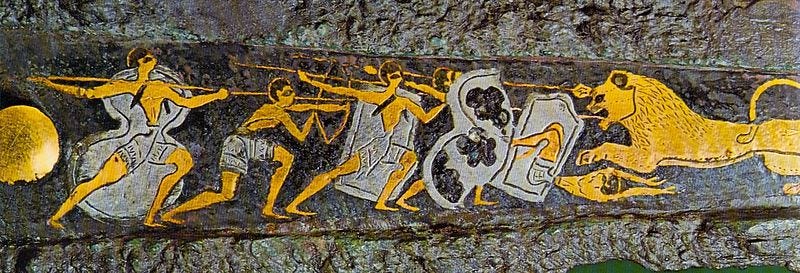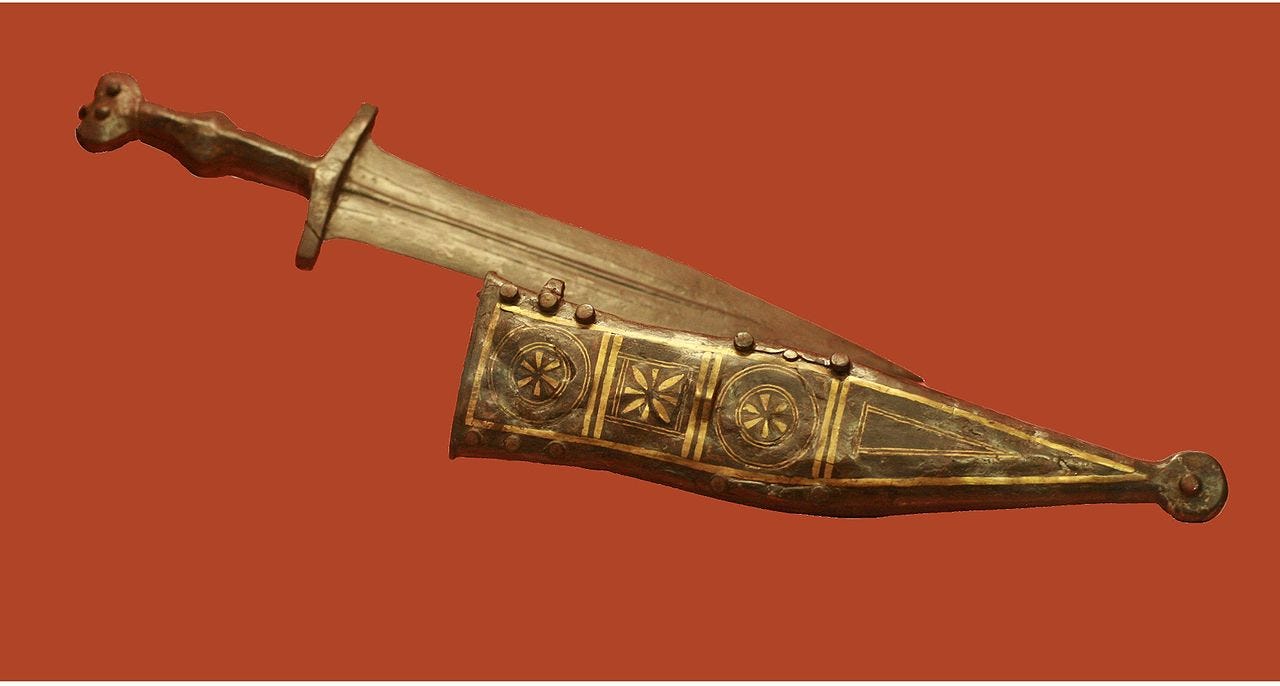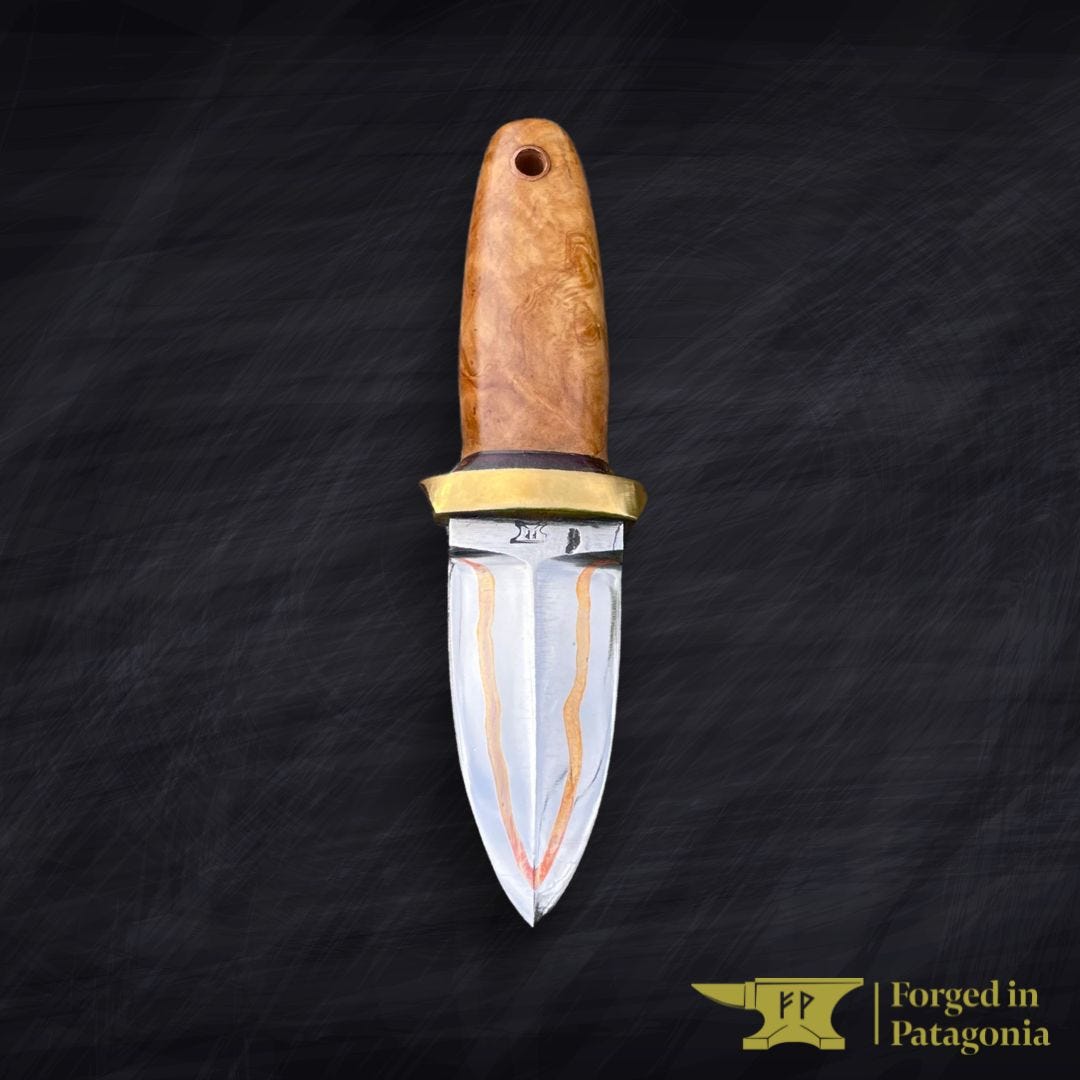
Dear Classical Wisdom Reader,
Long time readers may remember our managing editor from years back, Kristin Deasy. She’s not your average kind of person, which is exactly why we like her so much. From her days as a reporter in refugee camps in Syria to training as an Opera singer in Buenos Aires, or to her home now in the remote forests in the Patagonian mountains, Kristin follows her passions and interests to the literal ends of the earth.
So perhaps it shouldn’t have been surprising to me when the following article popped into my inbox. Why wouldn’t Kristin now know the in-depth makings and history of daggers? After all, she and her partner have set up a traditional workshop, fully operational and using ancient techniques in the shadows of the Andes.
Of course understanding daggers may appear fairly niche as a topic to discuss... but they have been absolutely instrumental in deciding the path of history. Whether in King Tut’s tomb or Julius Caesar’s back, daggers were constant companions in the ancient world.
So please enjoy this unique issue, dedicated to daggers and discover how they are far from being merely a weapon of war, below.
All the best,
Anya Leonard
Founder and Director
Classical Wisdom
Classical Wisdom is a reader-supported publication. Becoming a free or paid subscriber and take your love of the ancient world to the next level:
The History of the Deadly Dagger
By Kristin Deasy
Where did daggers first appear in the ancient world? The answer to that question is not entirely clear. The 3,400-year-old dagger from King Tut’s tomb is not believed to have even originated from Egypt, for instance, but rather Syria (in point of fact, it’s from outer space–more on that later).
In modern-day Crete, trade relations between the ancient civilization of Minoa and other leading civilizations during the Bronze Age inspired the Minoans to begin making daggers, some of which bear clear influences from as far away as Egypt.
Meanwhile, in ancient Rome, some claim the origin of the Roman pugia is in fact the Celtiberian bidiscoidal dagger. According to this view, Romans encountered the dagger during the Celtiberian Wars in the Iberian Peninsula in 218 BC. This, like many views on daggers throughout the ancient world, is debated by scholars. Indeed, the confusing origin of the dagger in the ancient world speaks to the role of trade and cultural exchange in the development of ancient tools and weapons.
Academics do agree on one thing, however: daggers are very, very old. Recent finds include a 5,000-year-old crystal dagger found in an Iberian tomb and a rare 4,000-year-old copper dagger discovered in Poland.
How Were Daggers Made?
Many of the ancient daggers that have survived today were made out of meteorites. Yes, you read that right, meteorites. That’s because the chemical composition of some meteorites, particularly those with iron and nickel, is strong and rust-resistant. These properties made meteorites far superior to other available materials. Flint, stone, ivory, or bone were also used to fashion primitive daggers in this early period.
In the Bronze Age, archeological evidence suggests that bronze-copper alloy daggers were fairly widespread. Research and analysis suggest these daggers were largely used on animal carcasses or carried as status symbols, rather than employed for explicitly military purposes. These items were cast, not heat-forged.
The origin of iron daggers is difficult to identify, nor is it clear exactly where the shift from meteorite-sourced iron to smelted iron, which requires some 2,200 degrees Fahrenheit, first took place.
Let’s take a look at some of the stand-out daggers of the ancient world...
Mycenae: The Lion Hunt Daggers
A clear testament to the use of daggers off the battlefield, these famous Mycenaean daggers portray hunting scenes involving lions. The bronze daggers are decorated with gold and silver inlays encrusted in black niello, a metallic alloy made of sulfur mixed with silver, copper, or lead. Dating from the 16th century B.C., several such daggers were found at a Mycenae burial site.
Cross-cultural influence is clearly evident on these blades. According to British Columbia’s course adopted from the “Boundless Art History,” one of the lion hunting daggers “depicts the influence of Minoan painting and imagery through the depiction of marine life” while “Egyptian influences are seen on a dagger filled with lotus and papyrus reeds along with fowl.”
Anatolia: The Alaca Höyük Iron Dagger
While X-ray studies have confirmed that this ~2400 BC dagger was made out of meteoric iron, the Hittites were reportedly one of the most advanced iron smelting societies of the period. This gold-hilted dagger was found in one of the tombs of the Hittite kings in the important archeological site of Alacahöyük in modern-day Turkey.
This dagger pre-dates the emergence of the Iron Age in the area by about 1,000 years. Nevertheless, sources say the Hittites were great lovers of iron, preferring it over other valued metals like gold. They even made thrones from it, as referenced by phrases such as, “The Great Hero King sat on his iron throne,” according to Anatolian Archeology.
Persia: (Scythian) Akinakes
Originally from Scythia, these short swords or daggers were memorialized by the Persians, who used them from the seventh century until the second century B.C. This type of dagger is featured prominently in Persian art, i.e. the reliefs at Persepolis and statues of the god Mithras.
According to A Dictionary of Greek and Roman Antiquities, Persians carried these 14-18-inch daggers on the right side, whereas Greeks and Romans typically carried their swords on the left. The same author states that for the Scythians, akinakes daggers were principally religious objects.
Rome: Pugio
The seven-to-12-inch long Roman pugio was a very popular dagger used by the Roman legionaries. Many iterations of the pugio appeared over the centuries, ranging from highly elaborate, gem-studded daggers to cruder, more utilitarian blades. Pugios were used from the first century BC until the fall of the Roman empire in the fifth century AD, putting in a special appearance in the assassination of Julius Caesar.
Many scholars believe the original design of the pugio came from the Cantabrians of the Iberian peninsula. The exact use or function of the pugio is a topic of ongoing study.
Daggers Still Link Ancient and Modern Worlds
Today, daggers are highly valued for many of the same reasons they were prized in antiquity. Owning an expensive dagger remains a status symbol among the wealthy, while for some, owning a dagger connects them to ritual. Knifemakers favor daggers for their balanced, symmetrical design and efficiency and many continue producing new interpretations of this iconic blade.
For example, this copper-and-steel cu mai dagger created by bladesmith Oskar of Forged in Patagonia harkens back to the copper-bronze alloy blades of the Bronze Age (the knife features a bronze guard), while the olive root handle is a nod to the Mediterranean basin.
In the modern world, knives and other ancient tools remain a surprising yet tangible link to the past. Their construction, history, use, and societal value tell us a lot about the ancient cultures that used them. The fact that they have not only lasted into the 21st century but continue to be reinvented by modern bladesmiths today makes them a blade truly worthy of note.
P.S. This is actually something I'm working on with Oskar. If you enjoy the history of daggers and want to have your own historical replica, you can create a custom order and support an independent artisan keeping ancient traditions alive here: www.forgedinpatagonia.com.
Más info en https://ift.tt/qPTJ19d / Tfno. & WA 607725547 Centro MENADEL (Frasco Martín) Psicología Clínica y Tradicional en Mijas. #Menadel #Psicología #Clínica #Tradicional #MijasPueblo
*No suscribimos necesariamente las opiniones o artículos aquí compartidos. No todo es lo que parece.






No hay comentarios:
Publicar un comentario